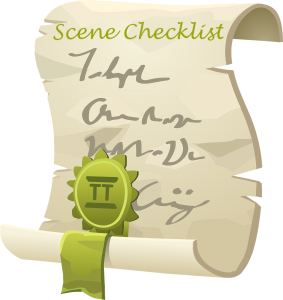“Scenes are capsules in which compelling characters undertake significant actions in a vivid and memorable way that allows the events to feel as though they are happening in real time.”
—Jordan E. Rosenfeld (Make a Scene)
Scene Checklist
Purpose
[ ] Has 3 reasons the scene should exist. Possibilities:
- Progresses or changes character’s goal
- Moves plot forward
- Adds conflict between opposing characters
- Introduces a character
- Develops a character
- Foreshadows
- Raises stakes
Structure
[ ] Clear beginning, middle, climax (disaster), and end.
[ ] Opening hook – lines that grab reader.
[ ] Opens mid action – not description or explanation.
[ ] Action scenes – goal->conflict->disaster. 1
[ ] Reaction scene – response->dilemma->decision. 1
[ ] Point of view (POV) character – character with the most to lose in the scene – reveal immediately.
[ ] Reader immediately grounded in who, what, where, when, why.
[ ] Setting – revealed through what POV character reacts to, sees, hears, does.
[ ] Something’s at stake, or story stakes are raised or reinforced – make situation worse, or stakes matter more.
[ ] Fear hovers – character might not meet her scene goal.
[ ] Actions –interesting; advance plot or exhibit character; performed in real time.
[ ] Pace – appropriate for what’s happening.
[ ] Mood, tone, or author’s voice – realistic for scene, and the book’s genre.
[ ] Obstacles – people, events, emotions, secrets get in the way of characters meeting their goals.
[ ] Climax (disaster) – relevant to the plot or characterization.
[ ] Element of suspense, surprise, twist, or foreshadowing – creates anticipation; delivers a worthy payoff relevant to plot or characterization.
[ ] Metaphor or symbol.
[ ] Ending hook – transitions to next scene; entices reader to read on.
Hero/Heroine
[ ] Clear wants, emotional and physical – drive actions, dialogue, thoughts.
[ ] Pushes away from something negative; pulls toward something positive (emotional or physical). 1
[ ] A hint of victory; two hints of failure. 1
[ ] Conflicting values.
[ ] Reader can identify or empathize; knows whom to root for.
[ ] Secondary characters – clear purpose for being in scene.
[ ] Hints of wounds, fears. Or competencies.
[ ] Reactions shown – to stimuli that affect feelings.
[ ] Balanced emotion, dialogue, internalization (considering scene type).
[ ] 5 senses included – sight, sound, taste, touch, smell.
[ ] Tight, every word needed.
[ ] Interesting; moves scene forward.
[ ] Natural – leaves out boring parts of actual dialogue.
[ ] Characters’ voices – distinctive; could know speaker by his word choices.
[ ] Reveals or hints at emotions, undercurrents, or secrets.
[ ] Reveals character, plot, conflicts, or bits of important information.
[ ] Includes a zinger – jibe, bold truth, dry or humorous comment. 1
[ ] Action beats or simple speaker attributes (said) – identifies speaker.
Avoid
[ ] Clichés – in dialogue, characterization, plot.
[ ] Coincidences (something drops in to save the day).
[ ] Vagueness (it, that, pronouns that don’t tie, etc.).
[ ] Clever writing that adds nothing; confuses.
Remove
[ ] Boring, purposeless sentences and paragraphs.
[ ] Detailed body movement descriptions.
[ ] Unnecessary explanations.
[ ] Weasel words – except when they work in dialogue.
Style
[ ] Shows often; tells as needed.
[ ] Clear, concise, uncomplicated sentences.
[ ] Correct words (dictionary and thesaurus).
[ ] Power noun, verbs.
[ ] Short narratives when necessary (getting from one place to another).
[ ] Active voice – limit “was.”
[ ] Positive form used when possible.
[ ] Backload – ending words (sentence and paragraph) that tie to passage’s meaning.
1 Idea from Susan May Warren’s MBT Deep Thinkers Retreat manual.
Transform your scene with this comprehensive checklist. Click to tweet.
What would you add to this checklist?



 RSS - Posts
RSS - Posts



Thank you for this!
You are welcome, Jean Ann. I hope it helps you. As some of these become part of your normal writing, you won’t need to go through all 50+ with each scene.
This makes sense, and I probably already have some of these memorized!
I think most of us do, Jean Ann. I look for strong verbs as I write. I probably go to a thesaurus, dictionary, or Flip Dictionary at least five times during a scene.
I’m printing this out so I can refer to it as needed. Concise and extremely helpful!
Robin, I hope it helps you. I’m usually surprised at how much I catch going through my checklist. My critique partner catches more, but a lot of those catches were on my check list!
That’s a long list! Do you use it before you write, or in editing?
Hi Jane, After researching check lists for editing, I added several items to the one I normally use. As I mentioned in another comment, some of these become part of normal writing, and I don’t have to check for them. I’m pretty good at looking for strong verbs and nouns, so don’t go hunting for those. This is a comprehensive list. I think each writer can create their own from it, depending on where they are in their writing career and where they have their most problems. Of course, critique partners will still find problems that fall through the cracks. :0)
It’s good to be able to identify our weaknesses, and have help if need be. This list is great for that, too.
And I can’t imagine anyone never needing another person to point out their blind spots!